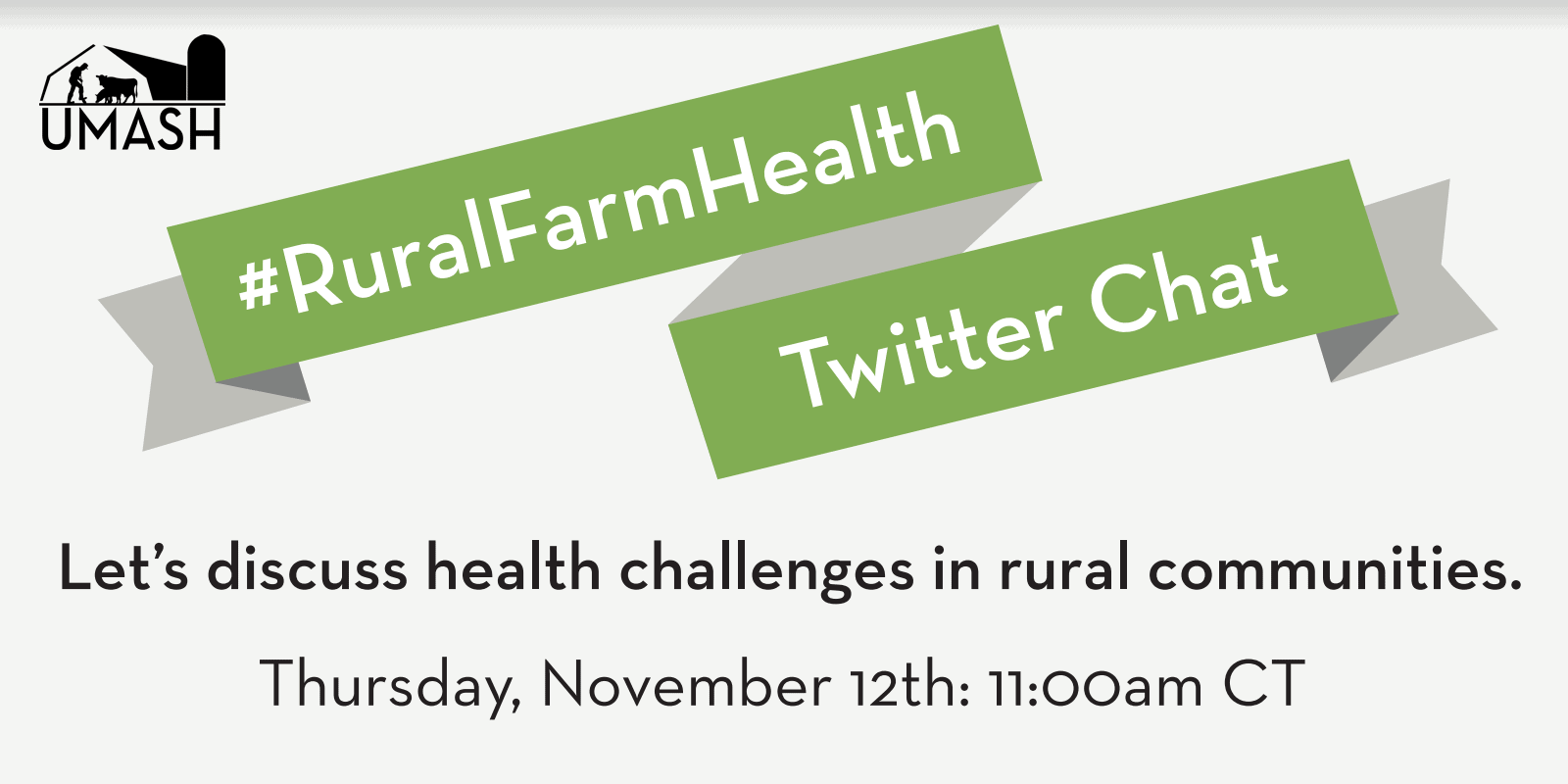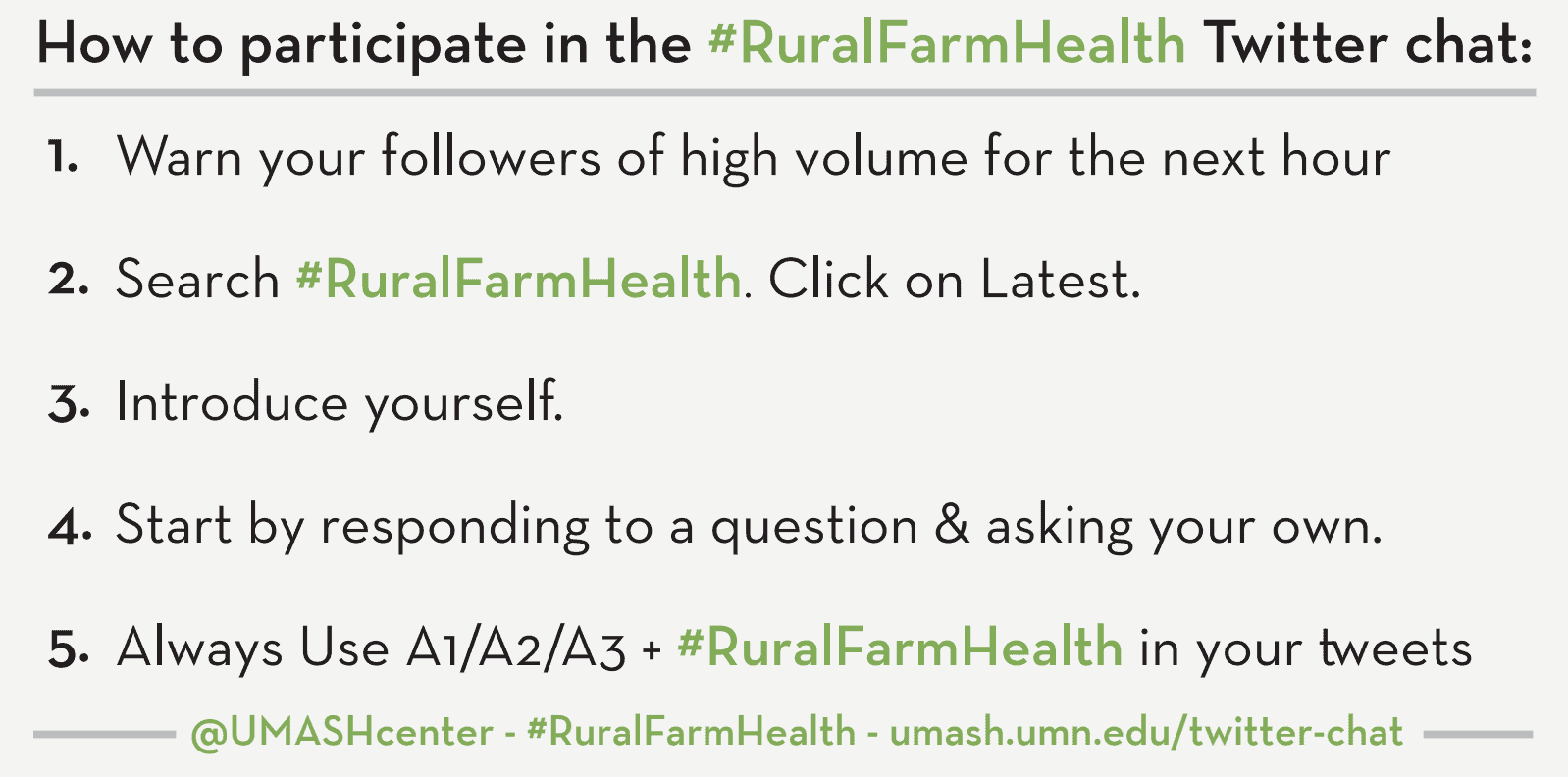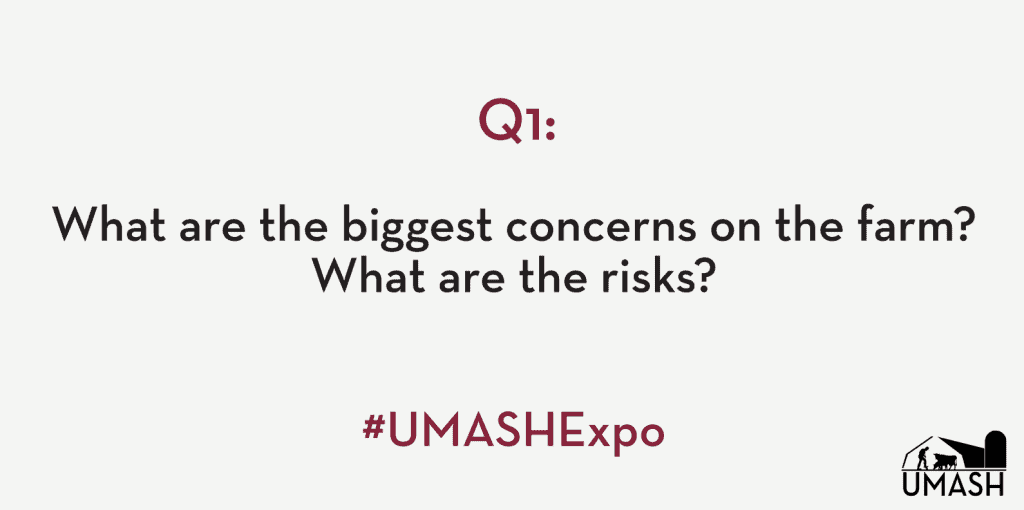![]() UMASH periodically holds Twitter chats about various farm safety and health topics. Below, you will find directions for accessing Twitter chats, upcoming chats, and saved conversations.
UMASH periodically holds Twitter chats about various farm safety and health topics. Below, you will find directions for accessing Twitter chats, upcoming chats, and saved conversations.
Interested in a particular topic? Message or email us at umash@umn.edu, and check out our Twitter page!
How do I join a Twitter chat?
- Each Twitter chat has a hashtag, which we will share on Twitter prior to the event. Search the hashtag, and click on Latest.
- Introduce yourself
- Start by responding to a question, then asking your own. Always use A1/A2/A3 + the hashtag in your tweets. Here’s an example.
Upcoming Twitter Chats
Check Back Soon!
Saved Twitter Chats
 THURSDAY, NOVEMBER 12
THURSDAY, NOVEMBER 12
11am Central
National Rural Health Day (NRHD) recognizes that rural communities experience unique healthcare challenges. Agricultural communities, including BIPOC producers, agricultural workers, and Tribal communities, experience their own set of challenges.
The #RuralFarmHealth Twitter chat was a success! Eighteen people attended, including a farmer from Northern Ireland. The conversation focused on rural healthcare for agricultural communities, broadband access, and farmworker health. Farmers, including farmworkers, face unique healthcare issues due to occupational exposures, off-farm jobs, lack of culturally-centered communication, and childcare. Lack of or limited health insurance exacerbates these issues, especially when mental health care is poorly covered by insurance. Additional healthcare challenges for rural agricultural communities include few providers, long distances to travel to a clinic, limited or no broadband service, lack of culturally-centered care, difficulty maneuvering through the health system for foreign-born and H2-A guest workers, and hospital closures. COVID-19 has made these issues that much more difficult. Attendees noted increased childcare duties, economic impacts of the pandemic including in off-farm jobs, social isolation, and limited PPE access.
Creative ways to address these issues include using a Total Worker Health approach, toolbox talks, different business models, providing healthcare to individuals without health insurance, conducting farm safety and health trainings over apps that do not require internet service, and including health messages in webinars, events, individual conversations, and ag media. To assist agricultural workers during COVID-19, a participant noted that there needs to be better screening, testing, distribution of PPE, and free vaccinations. There are also gaps in farm safety and health resources, including greenhouse safety, safety for energy farms, and Spanish resources for mink farming. When addressing all of these areas, it is important to take a health equity lens, incorporating diversity, equity, and inclusion efforts from the beginning.
- Hello! While isolating at home & social distancing are critical to combat #COVID19, these practices increase the risk for#abuse , #suicide, & child #injuries at home. In #rural America these risks could be greater. https://bit.ly/3e40RuQ @UMASHcenter #RuralFarmHealth
- A sobering reality. We recently discussed ways to come together while (physically) staying apart during this challenging time on our FB page: https://www.facebook.com/watch/live/?v=458236798499613&ref=watch_permalink
- A1: Farming can be physically demanding and lead to joint issues, exposure to loud noise without hearing protection, high levels of stress can lead to mental health crises…@UMASHcenter #RuralFarmHealth
- Trauma care for injured #farmers is often delayed by almost an hour compared with other rural workers according to a new @uiowa study: https://bit.ly/38eGU41
- A1: Overall health–physical, mental, and emotional; demanding work and long hours can lead to farmers neglecting certain areas of their health.@UMASHcenter #RuralFarmHealth
- Mental & emotional health play such a critical role in overall health outcomes. Thank you for reminding us of this!
- A1: Availability of jobs in rural areas with benefits as farmers often rely on these off-farm jobs for their health insurance benefits. https://choicesmagazine.org/choices-magazine/submitted-articles/health-insurance-and-national-farm-policy
- A1: Farmers have significant occupational sun exposure and increased risk of skin cancer. An increase in several skin cancers has been found in farmers. #RuralFarmHealth https://marshfieldresearch.org/Media/Default/NFMC/PDFs/Final%20Skin%20Cancer%20Screening%20Report.pdf
- Unique stressors! Work done by colleagues at @SDStateCAFES dairy extension found that Hispanic/LantinX dairy workers experience stress due to extreme weather, language barriers, intense work schedules, and living far away from family. #RuralFarmHealth https://progressivedairy.com/topics/management/being-a-dairy-worker-blessing-or-curse-it-will-depend-on-your-attitude
- #ChildHealth is a challenge! WISC continues contributing as the only rural and farm cohort in the ECHO study. This study combines pediatric cohorts focused on upper airways; peri-, neo-, and post-natal outcomes; neurocognitive development; obesity and more https://bit.ly/35niXFF
- A1: Agricultural communities experience many unique health challenges & concerns – some of which we don’t fully understand yet. This is why @AllofUsResearch is working hard to ensure rural communities are adequately represented in health research. #JoinAllofUs #RuralFarmHealth
- A1: Agriculture is one of the most hazardous industries, w/ #farmworkers & their families exposed to a myriad of chronic & acute #health risks. For more info, our Rural Ag Health & Safety topic guide discusses these health & safety issues: http://bit.ly/2uGWU7k #RuralFarmHealth
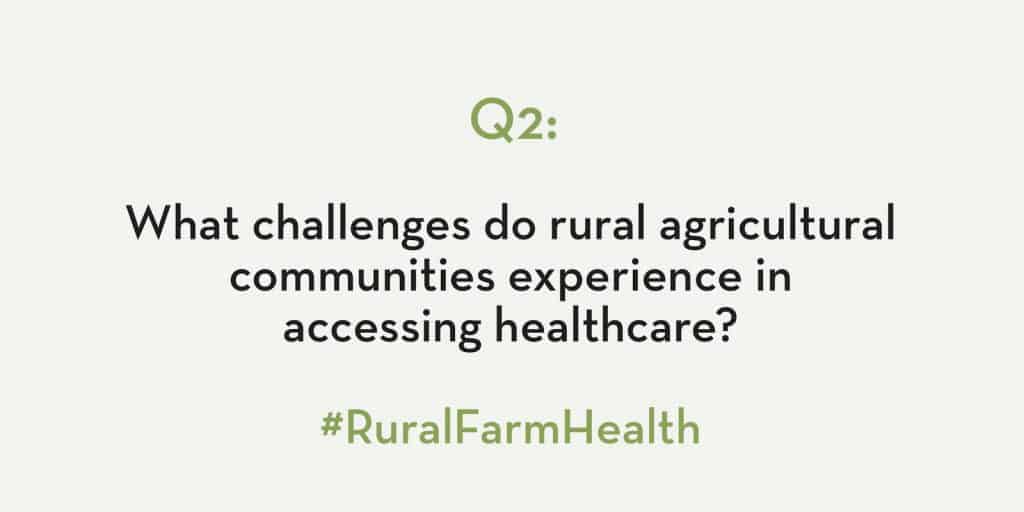
- A2: Lack of rural broadband makes it more difficult to access telehealth services, which could be helpful in getting necessary care to rural residents with the lack of physical providers.#RuralFarmHealth @UMASHcenter
- A2: I have been following #RuralFarmHealth today from here in UK, brilliant to have an insight into rural health in N.America! Lots of issues are very different incl the ag landscape but recruitment in rural areas globally seems to be a challenge for us all to overcome..
- A2: I think rural ag communities are at a disadvantage in accessing healthcare due to a lack of providers in rural areas and no or poor health insurance. @UMASHcenter #RuralFarmHealth
- Distance to care, getting specialty care, coverage/cost, accessing providers with understanding of occupational impacts of ag @UMASHcenter #ruralfarmhealth
- We cannot forget that coverage of mental health is not covered in some plans and in others it is very limited! #RuralFarmHealth
- A2: Complexity associated with using health insurance plans: desired providers not in-network, high out-of-pocket, and deductibles. #ruralFarmHealth
- A2. Foreign-born and H2-A guest ag workers have to learn to navigate the U.S. healthcare system! #RuralFarmHealth
- A2: “Closures of rural health hospitals and difficulties recruiting practitioners in rural areas make healthcare a huge challenge in rural areas.” #RuralFarmHealth becot.florence@marshfieldclinic.org
- A2: There is a lack of rural health providers in many areas. Some farmers need to drive over an hour just to visit a doctor. @UMASHcenter #RuralFarmHealth
- A2: Would you like to offer health insurance to your employees, but minimum requirements enforced by insurance companies make it difficult? Consider these questions: https://bit.ly/35rquDH #RuralFarmHealth
- A2: Rural agricultural communities have to travel further for healthcare and have fewer options when it comes to choosing providers. We’re proud to be partners with the @mfldclinic who have locations throughout rural #Wisconsin to help alleviate this challenge. #RuralFarmHealth
- A2: Some barriers to seeking #MentalHealth services in ag communities include a shortage of providers & stigma. The #Rural Response to Farmer Mental Health & Suicide Prevention issue guide includes info on addressing these barriers: http://bit.ly/3fz7CUU #RuralFarmHealth
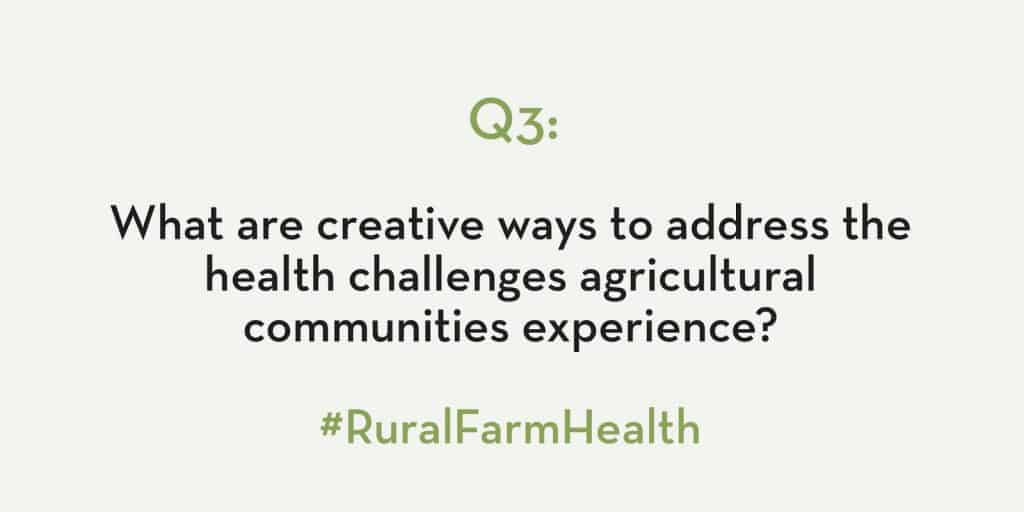
- A3. Integrate a Total Worker Health approach to worker safety and health programs! @SDStateCAFES dairy extension’s “toolbox talks” train workers on dairy protocols but also general wellness like healthy eating, eye health, and coping with stress.#RuralFarmHealth @UMASHcenter
- Great Idea!
- Totally! I always think of @AgriSafeNetwork total farmer health as well.
- Hub and spoke models, coops/other business models, there have been some creative clinics finding ways to provide care without insurance, but keeping rural communities vibrant as a whole certainly shouldn’t be overlooked @UMASHcenter #RuralFarmHealth
- A3: Many @UMNExt Educators integrate health messaging into their regular webinars and events; this allows us to capture farmers that maybe wouldn’t attend a “stress meeting” but would be interested in programs with production topics! @UMASHcenter #FarmRuralStress
- A3: Despite working in one of the most dangerous occupations, and being especially vulnerable to the coronavirus, many farmers and workers in the US have long lacked essential resources to ensure they can meet their health needs. #RuralFarmHealth https://tandfonline.com/doi/full/10.1080/1059924X.2020.1814924
- A3: By taking into consideration the lifestyle, environment, biology, & socioeconomics of people living in agricultural communities, researchers will be able to tailor creative and more precise prevention and treatment strategies. #precisionmedicine #RuralFarmHealth #JoinAllofUs
- A3: Candid farmer-to-farmer conversations, integrating health messages into mainstream ag media @UMASHcenter #RuralFarmHealth
- A3: This publication by Dr. Becot, Dr. Inwood, Dr. Bendixsen, and Dr. Henning-Smith answers this question very well! #RuralFarmHealth https://tandfonline.com/doi/full/10.1080/1059924X.2020.1814924
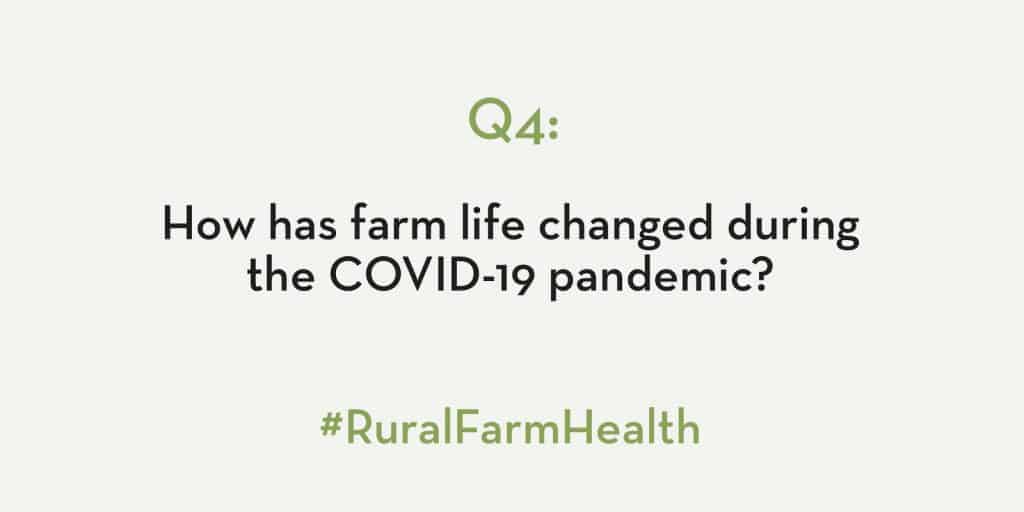
- A4: some children being home during spring planting and fall harvest. Balancing school, farm work, etc. Kids may want to help, but need to find age-appropriate tasks. #RuralFarmHealth @UMASHcenter
- A4: Day to day operations have been as busy as ever, but the challenge has been in not being able to meet face to face with seed customers and other farmers. Loneliness can be hard for many, and so many comm. better face to face. @UMASHcenter #RuralFarmHealth
- Our operation has really been affected by reduced farmer’s market sales-fewer vendors at every market, means fewer customers too. Basically no restaurant sales this year. Extended family contact is restricted. Think the most encouraging thing is all the ways people have adapted.
- Throw in the drop in the cheese price since the election and see how dairy farmers feel
- A4: COVID seems to have exacerbated existing stressors and added additional isolation, already a huge issue in farming and a risk factor for mental health. @UMASHcenter #RuralFarmHealth
- A4: [ For us the day to day hasn’t changed all that much. Cows and crops don’t really care about a global pandemic. I think where we are getting hit hard is the lack of social interaction. We already don’t have that much anyway, so that being decreased has been tough
- A4. From our stakeholders, we have heard that already stressful work has become more stressful, especially as our understanding of best practices evolves. #RuralFarmHealth @UMASHcenter
- A4: Many children have been staying home on the farm during #COVID where the #homelife and #worksite environment has a lot of crossovers. #RuralFarmHealth Here are some ways to keep your children safe: https://marshfieldresearch.org/COVID-19/resources/rural
- A4 – much has seemed steadily similar on our beef farm, but less sense of community, limited interactions with input providers, PPE access issues @UMASHcenter #RuralFarmChat
- A4: Farm production has been impacted, in a survey of 134 farm parents only 1/4 had not experienced a change in their off-farm job. Mostly included working from home (34%). Hear more on this report from Dr. Becot at the MRASH Confrence. #ruralFarmHealth https://bit.ly/3nhMM0z
- @SmallFarmDairy @FoulkShay @AGStateofMind1 curious to hear your thoughts on this

- @FarmMedicine @UMASHcenterBroadband access and Internet Use are both HUGE issues for all, especially for rural communities! Is there a way to ensure access to rural communities? Access is needed to reduce certain uncertainties in farming. #RuralFarmHealth
- A5. Online trainings are hard to access in our region due to limited broadband. Our dairy training programs utilize iPads and tablet-based training that can be completed without internet. #RuralFarmHealth @UMASHcenter
- Great point @HICAHS A5: It has also become more stressful for farm parents trying to help their children with virtual school work. Creating more mental anxiety! #RuralFarmHealth @UMASHcenter
- What a great option for those with limited access to broadband.
- A5: This has been a challenge for years, and more of a problem those working a second job off the farm were required to work from home using up the broadband needed for farm work. #RuralFarmHealth @UMASHcenter
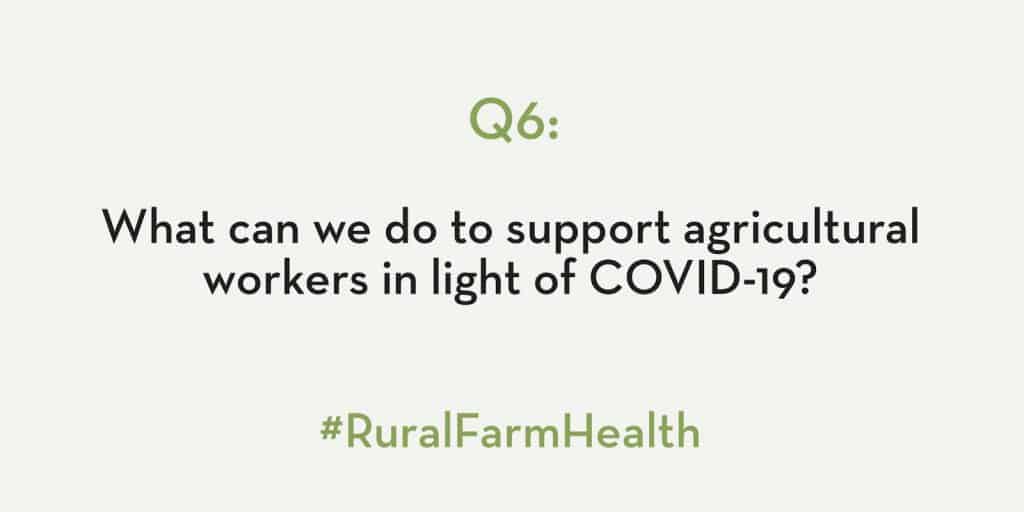
- A6: #BuyLocal by finding a local agricultural business and purchasing from them you can support your local ag workers! #RuralFarmHealth @UMASHcenter
- A6: When the pandemic began there were a lot of webinars. You can watch some of there here: https://marshfieldresearch.org/Webinar/Rural/COVID-19… to learn more about how to stay safe and healthy. #RuralFarmHealth @UMASHcenter
- A6. We need to advocate for greater access to the control strategies we know work: robust screening and testing, adequate supplies of PPE, and access to free vaccines! #RuralFarmHealth @UMASHcenter
- A6: YES! #PPE has been very hard for farmers to obtain and they need it for specific jobs and tasks they perform on a daily basis! #RuralFarmHealth
- A6: Participants in @AllofUsResearch, including Ag Workers, have the chance to participate in surveys that are geared at understanding the direct impacts of COVID-19 on different communities. #RuralFarmHealth
- A6: #RuralFarmHealth @NIOSH and the @CDCgov worked with 11 #AgHealthandSafetyCenters to create some guidelines to help farmworkers stay safe during #COVID. @UMASHcenter https://cdc.gov/coronavirus/2019-ncov/community/guidance-agricultural-workers.html
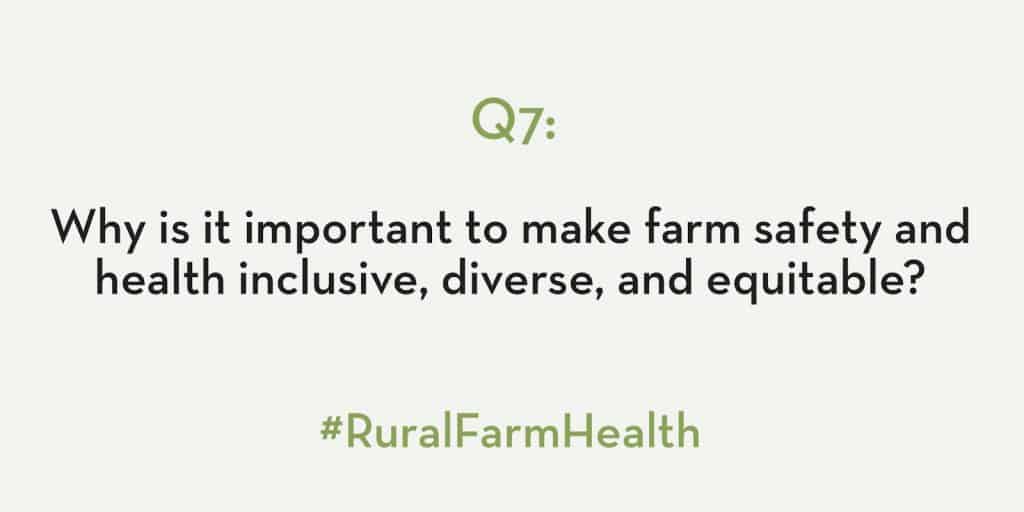
- A7: farm safety and health is for everyone! In Minnesota and across the nation we have farmers that are from other countries and backgrounds, speak multiple languages, and have various physical capabilities. No one is exempt from practicing safety! @UMASHcenter #RuralFarmHealth
- A7: @DairyCarrie does a wonderful job of answer this question in her Blogs: Humans-of-agriculture, specifically the #immigrants stories. https://dairycarrie.com/2017/02/09/humans-of-agriculture-the-immigrants-story/… #RuralFarmHealth @UMASHcenter
- A7. COVID-19 has shown us that ag workers are the foundation of the food system. When planning and implementing health and safety programs, we need to include the voices of the diverse people who make up this system. #RuralFarmHealth @UMASHcenter
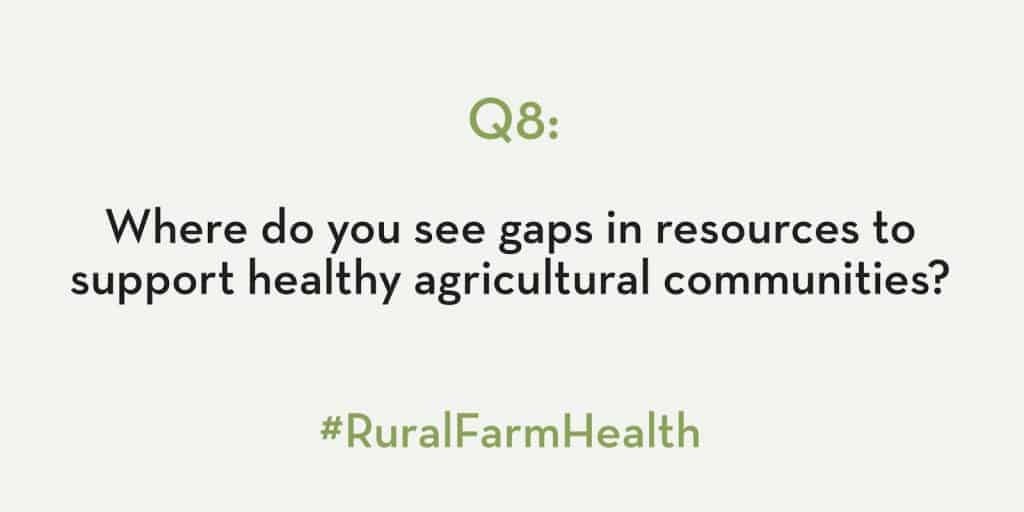
- Q8: A recent question shared on the @real_isash was: “Anyone have mink farm safety resources in Spanish? Specific to N95 and N99 respirators.” Some specific types of agriculture or #NitchAgriculture areas don’t have specific resources. #RuralFarmHealth @UMASHcenter
- A8. As we have already mentioned, there are fewer specialized healthcare providers in rural areas and telehealth services can be challenging to access for those without reliable internet and phone.#RuralFarmHealth @UMASHcenter
- A8: A question we have often gotten is: “Do you have a resource on Greenhouse safety?” While we have somethings in our Ag Youth Work Guidelines, we would love to know if anyone has more resources on this! #RuralFarmHealth @UMASHcenter https://cultivatesafety.org/safety-guidelines-search/?category=familyyouth
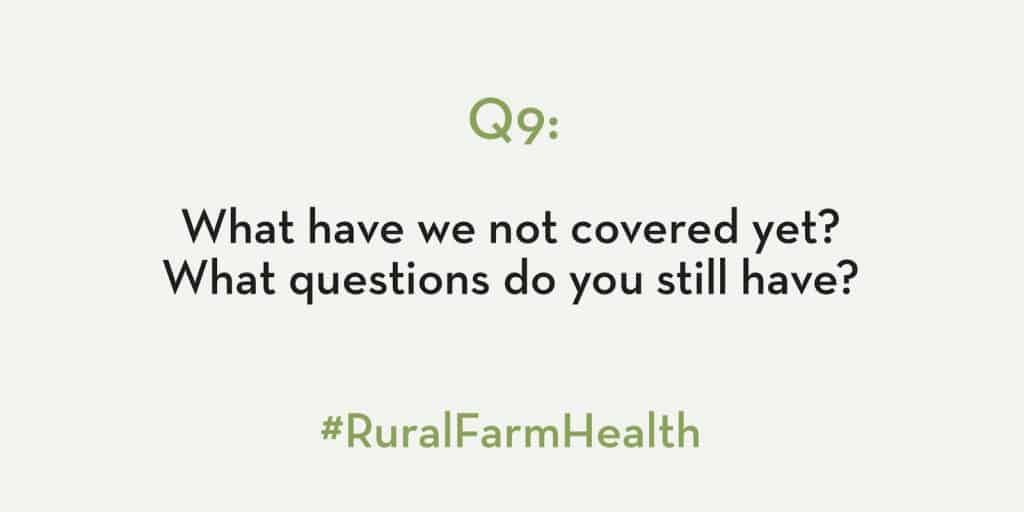
- A9: Great question asked by @PeterLundqvist1 “Anyone know any research regarding health & safety aspects during energy production on a farm level? Preparing a project application on hydrogen production on farms, including health, safety & security.” @real_isash #RuralFarmHealth
Eighteen people and organizations participated in the Twitter chat. The key theme of community ran throughout the conversation. Participants noted that farm incidents extend beyond the injured person, affecting healthcare personnel, family, and visitors. Communities all have an important role in reducing the spread of COVID-19. Participants discussed anxieties about respirator shortages, following proper precautions, the effect of the pandemic on farmworkers, and finding childcare. With work-life balance so difficult right now, this has implications on the mental health of communities. A participant noted the need for research to include rural communities. Another explained that it’s difficult to study farm safety when not all injuries are reported and such data isn’t widely available. Fortunately, farm safety can be incorporated in many ways, such as having nutritionists talk about zoonoses. The Twitter chat ended on a high note: There are many resources and organizations promoting farm safety.
- A1: According to the WI Farm Fatality Report, roadway deaths accounted for 29% of all farm fatalities. https://marshfieldresearch.org/nfmc/wi-farm-related-fatality-reports… #UMASHEXPO
- A1: Transportation incidents are the leading cause of death, but many hazards exist on the farm, & not just to workers but also to visitors, family members, EMS personnel, & other healthcare workers responding to accidents. #UMASHExpo @UMASHcenter
- #A1: Although the rate of non-fatal injuries to children in agriculture has dropped by 60 percent since the National Children’s Center was established in 1997, agriculture remains hazardous for children and youth. https://cultivatesafety.org/parent-first-farmer-second/… #UMASHExpo
- A1: Safety and health at ranches and dairies is a big concern in our region! Animal handling, zoonotic disease, bending and lifting, and use of heavy machinery are some of the health and safety concerns. #UMASHExpo
- A1 – finances, balancing the costs of operations, farm transition, low commodity prices, and the next (6th) generation on our farm.
- A1: Children and youth on farms and in the worksite are one of the biggest concerns. A child dies in an agricultural-related incident about every 3 days! #UMASHExpo
- A1: Grain bins, there’s a lot out-of-condition grain that can be dangerous to work around, especially when alone #UMASHExpo @UMASHcenter
- A1 – ATVs, tractors, equipment, and the presence of young children in the worksite. These are my top worries, in terms of farm safety. We expect to see more injuries and more exposure on the farm, as schools remain closed (or virtual) into 2021 #UMASHExpo @UMASHcenter
- A1 again – https://wcax.com/content/news/UVM-Medical-Center-calls-number-of-ATV-injuries-this-year-alarming-571700541.html…#UMASHExpo @UMASHcenter
- A1: The most common hazard with grain bins is engulfment. The primary causes are moisture and grain removal. Moisture can cause the grain to stick together and form a crust or bridge at the top surface of the grain. https://go.usa.gov/xfGvF #UMASHExpo #TwitterChat
- A1: Tractor roll overs and run overs are a big risk on farms. #UMASHExpo
- A1 – New reports show 41 WI ag-related deaths in 2017 & 34 in 2018. Large % was from public road collisions. Follow all state lighting and marking requirements for older equipment & federal regulations for newer machinery. https://bit.ly/fatreprelease #UMASHExpo @UMASHcenter
Top Critical Risks on farms could be:
- Vehicle rollover/runover
- Entanglement
- Electrocution
- Hazardous substances
- Handling livestock
- Fall from heights
- Drowning
- Confined space entry
- A2: Rural #firefighters and first responders are highly esteemed in #ruralcommunities. With tools and knowledge, they can be influential on farmers’ health and safety decisions in their communities. https://umash.umn.edu/portfolio/rural-firefighters-delivering-agricultural-safety-and-health-rf-dash/… #UMASHExpo
- #A2: Visiting agritouism sites can teach our youth a lot about agriculture and where our food comes from, but we need to make sure the sites are safe. Especially now during a worldwide pandemic. This site can help keep communities safe: https://safeagritourism.org #UMASHExpo
- Q2: I think we all have an opportunity to lead well – so model healthy behaviors and continue to learn and talk with community members and partners #UMASHExpo @UMASHcenter
- A2: We work hard to encourage our rural communities to participate in research. Hopefully that research will contribute to keeping them both safe and healthy.@UMASHcenter #UMASHExpo
- A2: Communities can support agriculture through strong youth programs like 4H and FFA, farmers markets, ordinances which benefit production ag, and the promotion of buying local. @UMASHcenter #UMASHExpo
- Staying safe during COVID-19 with federal protections, varying state regs means farmworkers depend on local communities to help them stay safe. Local health departments, local health centers, local advocates partnering with workers and employers. #UMASHExpo
- R2: We need to take responsibility, take the farming seriously in every aspect. From small farms to big ones, we need better regulations #UMASHExpo @UMASHcenter
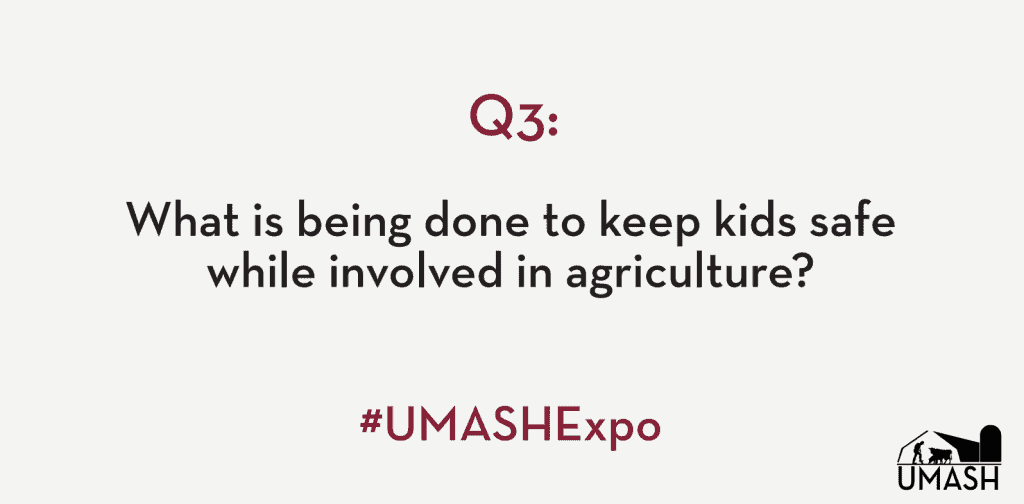
- A3: The protecting children while parents work project works to improve access to childcare for children of farmworkers by identifying common ground among key stakeholders. https://cultivatesafety.org:/resourcesearch/?view=r-73 #UMASHExpo
- A3: HICAHS collaborators at @USUCAAS, @MontanaState, and @AgEdS_IaStateU are testing ag safety training and curriculum implementation with ag and #FFA educators across the region. https://col.st/ZuuRd #TeachAg #UMASHExpo
- #A3: Playing is an important means for children to develop physically, emotionally, socially, and intellectually. But we need safe play areas where children have barriers so they cannot get into the worksite or dangerous situations. https://cultivatesafety.org/play/ #UMASHExpo
- A3: @NCCRAHS is creating evidence based resources and community engagement. They help to know when kids are ready for certain jobs on the farm. https://cultivatesafety.org #UMASHExpo @UMASHcenter
- A3 The National Safety Tractor and Operation Program provides safety training for 14 and 15 years who want their DOL certification to work in ag off of their family farm. https://extension.psu.edu/national-safe-tractor-and-machinery-operation-program…@UMASHcenter #UMASHExpo
- A3: We have also created a network of people interested in Child Ag Safety called the CASN Network! You can become a member too! https://cultivatesafety.org/casn/ #UMASHExpo
- A3 – we keep the young kids out of the worksite #UMASHExpo #TwitterChat @UMASHcenter
- A3 – training, supervision, high visibility clothing worn by anyone working or visiting the operation. Safety needs to be a priority, a passion. #UMASHExpo #TwitterChat @UMASHcenter
- Progressive Ag has great Farm Safety info! https://progressiveag.org #UMASHExpo
- A3: Our Safety Grants Program awards a dollar-for-dollar match up to $10,000 to qualifying employers or farmers for projects designed to reduce the risk of injury or illness to their employees.
- Visit https://go.usa.gov/xfGwK for more details. #UMASHExpo #TwitterChat @UMASHcenter
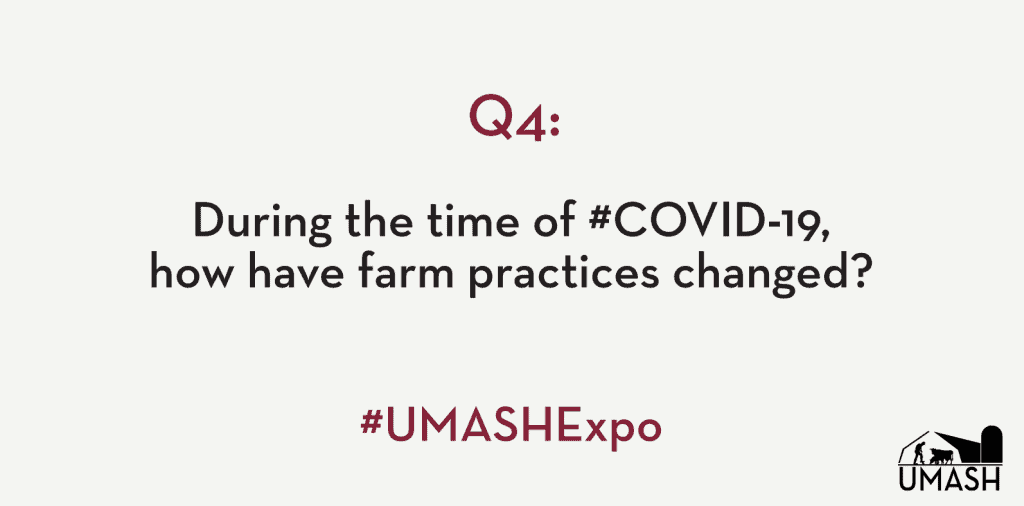
- Q4: Respirators (like N95s) have been in short supply. We created a document with @ahsa_aghealth and @UNMC_CSCASH on how to conserve supplies and reuse respirators, if needed. #UMASHExpo #COVID19Ag English: https://col.st/5Z861 Spanish: https://col.st/pXsKi
- A4: Worksite guidance for COVID-19 prevention in employer-furnished shared worker housing, transportation vehicles and work settings; this guidance doc will help farmers: https://cdc.gov/coronavirus/2019-ncov/community/guidance-agricultural-workers.html… #UMASHExpo
- A4 – there has been increased challenge when discussing and planning for childcare options, which was already often a struggle for many farm families — caring for children outside of the worksite, pre- #COVID19 #UMASHExpo #TwitterChat @UMASHcenter
- A4: A big challenge in the beginning was having kids at home from school or no child care and farm tasks still needed to be completed. Overall, mental health issues for everyone are a huge issue for the farming community. @UMASHcenter #UMASHExpo
- Due to COVID-19 many children that would have been in school, sports, or childcare are home; so there is a lot more work to do while keeping children out of the worksite. Safe Play areas are one way to help with this new norm: https://cultivatesafety.org/play/ #UMASHExpo
- A4: It’s not recommended to share or have multiple riders in farm vehicles because of #COVID19 . Tips we created with #CSUExtension: English (https://col.st/BWO64) and Spanish (https://col.st/f7DhM) #UMASHExpo
- A4: There have been so many impacts from COVID-19 on our rural community. We hope to learn more specifically about our rural and farm partners when they participate in the monthly COVID-19 Participant Experience Survey. #UMASHExpo
- Q4: The division between home and workplace on the farm was difficult before but COVID has taken it to a whole new level. @UMASHcenter #UMASHExpo

- A5: Check out RHIhub’s topic guide on #Rural Agricultural Health and Safety for a collection of resources, organizations, funding opportunities, events, and program examples. #UMASHExpo http://bit.ly/2uGWU7k @UMASHcenter
- A5: Our Rural Response to Farmer Mental Health and Suicide Prevention issue guide compiles an array of resources dedicated to addressing the rising #mentalhealth crisis in #rural farming communities. #UMASHExpo @UMASHcenter https://bit.ly/3fz7CUU
- A5 – there are so many resources and materials available, including those shared by the organizations participating in today’s #TwitterChat. There are also financial resources available in some states to assist with farm safety projects, including ROPS #UMASHExpo @UMASHcenter
- A5: There are so many great resources! You can find many in our resource library! Anything from children’s safety to mental health, to posters and signs. Search around and find a lot here: https://cultivatesafety.org/resourcesearch/ #UMASHExpo
- A5: Another resource: Many farm families rely on off-farm jobs for health insurance; sudden layoffs and furloughs might mean that farm families are losing their coverage. https://marshfieldresearch.org/nfmc-news/health-insurance-options-for-farm-families…. #UMASHExpo
- #A5: We have a resource library. It includes: fact sheets, reports, guidelines and other materials focused on agricultural health, safety and wellbeing. Resources are added frequently, so check back often! #UMASHExpo https://cultivatesafety.org/resourcesearch/
- A5: On more great resource: Tractors are the leading cause of deaths on farms. Apply for your ROPS today and get a 70% rebate. http://ropsr4u.org #UMASHExpo
- A5 – …and to stay informed of recent ag related injuries and fatalities, be sure to sign up for @AgInjuryNews (FREE)- run by the @FarmMedicine center, with collaborators from around the globe @TwitterChat #UMASHExpo @UMASHcenter @NCCRAHS @planfarmsafety
- A5: The @MNagriculture new cost share program #UMASHExpo @UMASHcenter https://mda.state.mn.us/grainstoragesafetycostshare
- A5: The Safety in Agriculture for Youth (SAY) Project through @USDA_NIFA has the SAY Clearinghouse which is a one-stop for ag safety and health curriculum and resources for youth educators especially 4-H and FFA. @UMASHcenter #UMASHExpo http://ag-safety.extension.org/SAY
- Our Workplace Safety Consultation service provides free voluntary and confidential workplace safety and health assistance to Minnesota businesses, with a priority for farms and small businesses. #UMASHExpo @UMASHcenter

- A6: We see a gap in fatality and injury surveillance. We can’t know what resources are needed if we don’t know the cause. We use http://AgInjuryNews.org to help us find media mentions of farm incidents to fill those gaps. @AgInjuryNews #UMASHExpo
- #A6: While farms can be a great place to live, work and play, they can also be dangerous. Explore the categories here to learn more about accidents and preventing injuries to youth on farms. https://cultivatesafety.org/accidents/ #UMASHExpo
- A6: I think it needs to be a part of all farm conversations/agribusiness even if it’s subtle. So maybe tag a zoonotic infection intro to a dairy nutrition talk. #UMASHExpo
- A6: Agree with @weicheltb on the financial incentives and take it to the next level to help farmers and ranchers better understand that investing in safety is good for their bottom line and the future of their farm operation. @UMASHcenter #UMASHExpo
- 1/2 Rural communities haven’t always been included in research. This means research is missing a key portion of the population+not necessarily addressing that community’s needs. We are working to enroll a million or more people to better reflect the diversity of the US #UMASHExpo
- 2/2 A6: We are happy to help give representation in research to the rural community. We are also grateful for other organizations, like @FarmMedicine who do great work and research for the farm community too! They are so valuable! #UMASHExpo @UMASHcenter

- A7: Personally, we love the #NIOSH Ag centers! @BassettNetwork @HICAHS @NCCRAHS @AgHealthUCD @sccAgSafety @GPCAH @SCAHIP @UMASHcenter @agsafety_cscash @SouthwestAg95 @PNASHCenter #UMASHExpo
- #A7: There are too many to name, but we do appreciate @CDCgov, @NIOSH, and the other 10 ag centers: @BassettNetwork @HICAHS @AgHealthUCD @sccAgSafety @GPCAH @SCAHIP @UMASHcenter @agsafety_cscash @SouthwestAg95 @PNASHCenter #UMASHExpo
- A7 – @real_isash and @ASHCA07 for sure! Two of the most important “networking hubs” for the work that we do! #UMASHExpo @UMASHcenter
- A7: @NCCRAHS @AgriSafeNetwork @AgInjuryNews and of course @UMASHcenter #UMASHExpo
- A7: @NatlAgrAbility and @OhioAgrAbility!
No specific question
- Long hours, isolating work, unexpected weather, and fluctuating prices make agricultural work a stressful job. It is important we let farmers know that there are resources and people waiting to help, especially in these difficult and uncertain times. #farmstress #UMASHExpo

